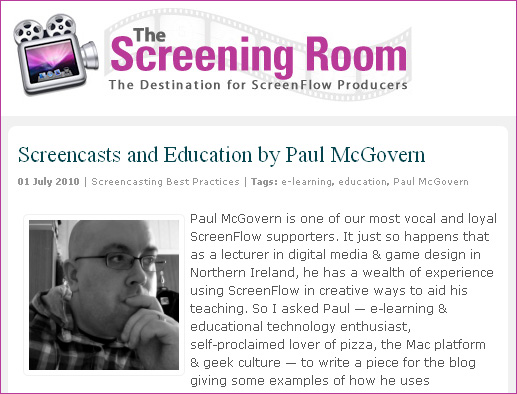..
Teaching with Digital Video — from ISTE by Lynn Bell and Dr. Glen L. Bull
With digital video, your students can:
Watch a demonstration of the speed of sound
Analyze classmates’ poetry performances
Create videos that document cultural differences
And the best part is that it’s engaging. Your students are most likely already watching, creating, uploading, and sharing digital video in their spare time, so why not incorporate this tool they already enjoy in the classroom?
Bull and Bell bring together lesson plans, ideas, and resources aligned with the National Educational Technology Standards (NETS) and content-area standards so that you can use digital video in the classroom effectively. The book also includes information on acquiring, creating, and communicating with digital video.
Learn more about this book and topic: listen to an interview with the editors Glen L. Bull and Lynn Bell on ISTE Casts.
Also relevant here:
- Pennsylvania establishes first statewide Digital Learning Library — from eSchoolNew.com by Meris Stansbury
Pa. partners with PBS, Penn State University to give educators free access to standards-aligned digital media content
Screencasts to support learning
I believe there are a number of reasons why screencasts are extremely effective as educational tools and I have outlined these below:
1. Time-flexible learning
2. Support Web 2.0 expectations of learners
3. Enhancement of the learning process
4. Enhancement of learning engagement
Let’s take a look at these one by one….
Coincident TV (CTV) is transforming the way interactive video content is created, consumed and monetized. Coincident TV enables immersive “hypervideo” experiences – the real-time integration of online video with social media, weblinks and transactions. The Coincident TV software suite allows content creators and distributors to easily design, manage and measure interactive video engagements across all digital platforms, including both HTML5 and Flash.
Example:
Hyper Aquarium Demo [Learn about interactive video with an explanation of our aquarium demo]
From DSC:
Again, think of the possibilities here for education…especially on a wall-sized, iPad-like, interactive, multi-touch chalkboard!
Instructional Design Ideas for Engaging Courses — from Learning Objects by Dr. Nancy Rubin
Designing e-learning for IMPACT — from Lars is Learning
Creating an engaging, effective e-learning experience can be a daunting task.
Interaction
Multimedia
Personal
Actionable
Challenging
Timing
Augmented reality takes hold in classrooms — from eSchoolNews.com by Laura Devaney
Educators say enhanced learning experiences can lead to engaging lessons; augmented reality overlays digital images and information on real-world settings.

A small but growing number of schools across the nation are turning classroom lessons into engaging experiences with augmented reality (AR), a technology that overlays digital information on top of real-world surroundings as viewed through a smart phone or other handheld, GPS-enabled device.
Proponents of the technology in education say augmented reality differs from virtual reality in that while virtual reality aims to replace a person’s perception of the world with an artificial world, augmented reality enhances a person’s perception of his or her surroundings.
The Augmented Reality Development Lab (ARDL), from virtual reality developer Digital Tech Frontier, lets users display relevant information at the appropriate time and location during an AR experience, which results in virtual 3-D objects appearing in the real world.
Also see:
http://virtualrealitydevelopmentlab.com/
The 3D Evolution: Part I, Introduction — from Innovative Interactivity by Tracy Boyer
I asked II multimedia education contributor Lynn Marentette to research the emergence of 3D technologies and how it might impact the educational sector. I’ve been really intrigued by this concept and how we might be able to develop interactive 3D applications for a TV console and from my conversations with Lynn, it sounds like this is a promising field that we need to closely watch. We will be cross blogging this biweekly series on here and Lynn’s blog “Interactive Multimedia Technology.” Below is her introduction to the series, which she initially published over at IMT. As always, please let us know if there is a particular issue, question, and/or concept that you would like us to tackle in this series.
I will be featuring topics related to 3D technologies in a series of future posts on the Innovative Interactivity blog. Look forward to discussions on topics related to the history of 3D in films, virtual reality, and games. I’ll also touch on the history of 3D, including films, the evolution of 3D technologies, and the role of the virtual reality and gaming fields in this development. I will also discuss how 3D technologies might impact the future of interactive multimedia, in education, in the home, and the web.
TEDxTalks — April 12, 2010 — Dan Meyer teaches high school math outside of Santa Cruz, CA, and explores the intersection of math instruction, multimedia, and inquiry-based learning. He received his Masters of Arts from the University of California at Davis in 2005 and Cable in the Classroom’s Leader in Learning award in 2008. He currently works for Google as a curriculum fellow and lives with his wife in Santa Cruz, CA.
For an excellent example of how to bring the world of multimedia into a math problem, click on the graphic below:
My thanks to Mr. Caleb Kuntz, Calvin College Teaching & Learning Digital Studio, for the heads-up on Dan Meyer’s Ted Talk
























